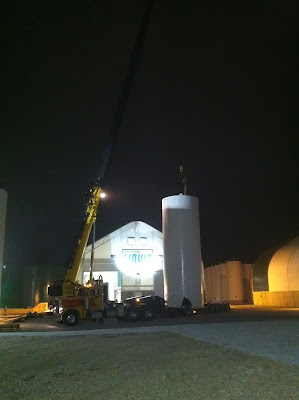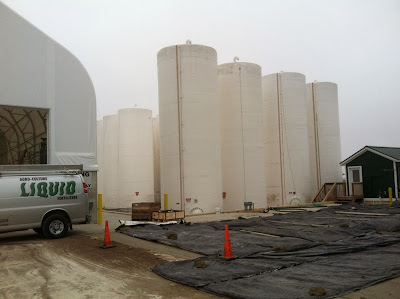When you first read the title of this blog post, you were probably shocked that this feat is humanly possible. Well it is, and all it requires is 5 or 6 worthy helpers, a forklift, a scissor lift, 50' of rope, 200' of 1/8" cable, some cable clamps, 1 retro-fitted tree stand, a whole lot of gawkers, and some blood, sweat and tears. Oh, and I should add, it requires a large room with at least a 28' tall ceiling. Below are your step by step instructions. Enjoy!
1. Fasten the rope somewhere on the top portion of the tree and pull from an elevated platform. You should have someone, or better yet, a 500 pound stationary object hold the base of the tree from sliding. You will need 2 or 3 of your helpers to submerge themselves in the branches of the tree and push toward the puller. Warning: Your hands, hair, and any other exposed body parts will be sticky after this step.
2. Continue pulling, even if the guys pushing from the bottom are adding additional weight because they didn't understand they were supposed to push, not climb.
3. Make sure there are many spectators available. Even though you may want them to leave the premises until the tree is up, they mean well offering their support. Who knows, with all those spectators excercising their photography and video taking skills, you may end up being a popular entity on one of those fun loving social websites I have such a high regard for.
4. When you have it about half way up and everyone is sweating and grunting and it looks like you may have to throw in the towel..............drop the tree. Take a moment to re-evaluate the situation. This may take a couple hours, but just make sure Plan B is better than Plan A.
6. This is what your tree should look like if someone with a good set of eyes levels it. At this point, the cables are fastened from the upper portion of the tree to various parts of the building. You'll want to fasten the cables high enough to avoid clothes lining anyone walking through the lobby.
7. And here is the finish product complete with decorations and a train. Thank you to everyone who participated in the production of this instructional - especially the sappy guys. I mean the guys who are still trying to wash the sap off.
The word floating around the office is that we're going for a 30' + tree next year. We might as well take advantage of all that ceiling space.


















